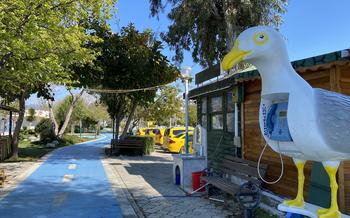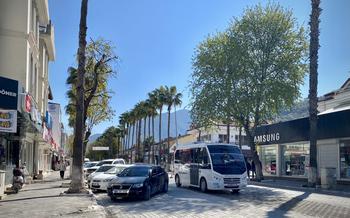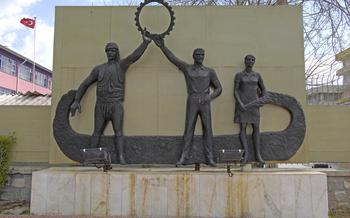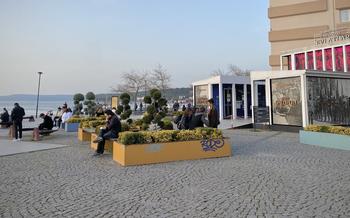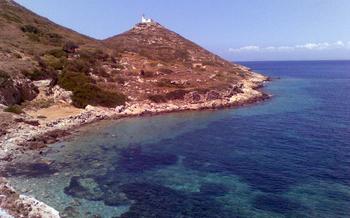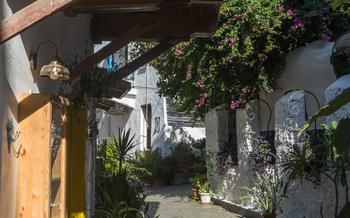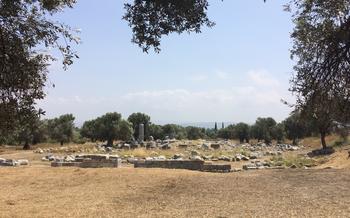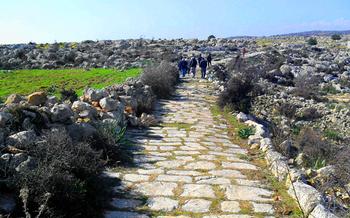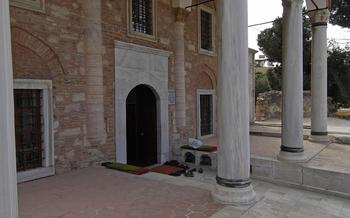
Lamos Ancient City
- Lamos Ancient City: A Journey Through Time
- Exploring the Ruins
- The Agora: Center of Public Life
- The Theater: Witnessing Ancient Performances
- The Necropolis: Eternal Resting Place
- The Walls: Fortified Protection
- The Temple of Apollo:
- The Roman Baths: A Place of Relaxation
- The Mosaics: Intricate Artworks
- The Aqueduct: Source of Life
- The Olive Groves: A Culinary Treasure
- The Beaches: Pristine Coastal Delights
- The Local Cuisine: Tantalizing Flavors
- The Village of Bozyazı: A Rustic Retreat
- Insider Tip: Best Time to Visit
Lamos Ancient City: A Journey Through Time
Nestled in the picturesque town of Erdemli, within the Mersin province of Turkey, lies the enchanting ancient city of Lamos. Its history dates back to the 7th century BC when it was a thriving port city under the rule of the ancient Greek civilization. Lamos reached its zenith during the Roman period, becoming a significant cultural and commercial center. It played a crucial role in the region's trade and served as a strategic military outpost. Today, Lamos stands as a testament to the rich history and cultural heritage of Turkey, inviting visitors to embark on a journey through time as they explore its well-preserved ruins.
Lamos's strategic location contributed to its prominence. Situated along the Mediterranean coastline, it served as a vital trading hub, connecting Anatolia with the broader Mediterranean world. The city's accessibility via land and sea routes further enhanced its importance, fostering cultural exchanges and economic growth.
Exploring the Ruins
Lamos Ancient City is a treasure trove of architectural wonders, each whispering tales of a bygone era. As you wander through the ruins, you'll encounter a captivating array of structures that showcase the city's rich cultural heritage.
The Agora, the bustling heart of ancient Lamos, is a sight to behold. This vast open space once hosted a vibrant marketplace, where merchants from near and far traded goods, ideas, and stories. The surrounding colonnades, with their graceful arches and intricate carvings, add an air of grandeur to the agora.
The Theater, a testament to the city's love of the arts, is an impressive sight. With its well-preserved stage, orchestra pit, and tiers of seating, it's easy to imagine the vibrant performances that once graced this stage. The acoustics are remarkable, ensuring that every word and melody reached the farthest corners of the theater.
The Necropolis, a solemn reminder of the city's past, is located just outside the ancient walls. Here, you'll find an array of tombs, each with its unique story to tell. From simple graves to elaborate mausoleums, these resting places offer a glimpse into the funerary practices and beliefs of the ancient Lamosians.
The Walls, once a formidable defense against invaders, now stand as silent guardians of the city. Constructed with precision and strength, these walls feature towers and gates that once protected the inhabitants from harm. As you walk along the ramparts, you'll be struck by the sheer scale and grandeur of this defensive system.
The Agora: Center of Public Life
In the heart of Lamos, the agora served as a bustling hub of ancient civic life. This central square was not merely a marketplace but a multifunctional space that encompassed religious, political, and commercial activities. Here, the city's inhabitants gathered to trade goods, exchange ideas, participate in religious ceremonies, and engage in political discussions.
The agora's strategic location allowed for easy access from all parts of the city. Around its perimeter, various structures lined the square, each serving a specific purpose. Shops and stalls displayed an array of goods, from pottery and textiles to fresh produce and imported spices. Temples dedicated to various deities, such as Zeus and Athena, provided a spiritual sanctuary within the marketplace. Government buildings, including the council chamber and administrative offices, played a crucial role in the city's governance.
The agora was a place where people from all walks of life converged, creating a vibrant and diverse atmosphere. The air was filled with the sounds of haggling merchants, the laughter of children playing, and the speeches of politicians addressing the public. The agora was more than just a commercial center; it was the beating heart of the ancient city, where the community came together to conduct business, socialize, and shape the course of their city's destiny.
The Theater: Witnessing Ancient Performances
Amidst the ruins of Lamos, the theater stands as a testament to ancient artistry and entertainment. Built sometime in the 2nd century AD, this structure served as a gathering place for citizens to witness theatrical performances, musical concerts, and public events.
With a seating capacity of approximately 5,000, the theater boasts remarkable acoustics, allowing performers' voices to carry throughout the auditorium. The stage area, adorned with intricate carvings and sculptures, provided a backdrop for dramatic performances and musical recitals.
The theater's design reflects a blend of Greek and Roman influences, showcasing the cultural diversity of Lamos. The tiers of seating, rising steeply from the orchestra, offered spectators an uninterrupted view of the stage.
Attending a performance in the Lamos theater would have been a highly anticipated event for ancient citizens. Audiences could immerse themselves in tales of mythology, tragedy, and comedy, brought to life by talented actors and musicians.
Imagine the atmosphere as the theater filled with anticipation, the buzz of conversation echoing through the stone walls. The performers took their places, their voices resonating across the rows of seats, captivating the audience with their artistry.
While the theater is no longer in use for performances, visitors can still marvel at its grandeur and acoustics, imagining the vibrant spectacles that once took place within its walls.
The Necropolis: Eternal Resting Place
Lamos's necropolis, located just outside the city walls, offers a glimpse into the funerary practices of its ancient inhabitants. Dotted with various types of tombs, from simple rock-cut graves to elaborate chamber tombs, the necropolis provides a fascinating glimpse into the lives and beliefs of the Lamosians.
The most common type of tomb found in the necropolis is the rock-cut tomb, which was carved directly into the soft limestone bedrock. These tombs typically consisted of a single chamber, where the deceased was laid to rest with their personal belongings. Some of these tombs feature simple inscriptions or decorations, providing insights into the names and families of the deceased.
Chamber tombs, on the other hand, were more elaborate and reserved for wealthier families. These tombs consisted of multiple chambers, often decorated with frescoes, sculptures, and inscriptions. They provide a wealth of information about the social status, religious beliefs, and artistic traditions of the Lamosians.
One of the most notable tombs in the necropolis is the Tomb of the Gladiators, which features a series of frescoes depicting gladiatorial combats. This tomb offers a rare glimpse into the world of ancient gladiatorial games, which were popular throughout the Roman Empire.
Exploring the Lamos necropolis is a moving experience that allows visitors to connect with the past and gain a deeper understanding of the lives and beliefs of the people who once called this ancient city their home.
The Walls: Fortified Protection
In ancient times, city walls served as a vital line of defense against invaders and marauders. Lamos, like many other ancient cities, was surrounded by a sturdy wall that protected its inhabitants and their way of life. Constructed from locally sourced stone, the walls were meticulously designed to withstand attacks and provide a sense of security to the city's residents.
The walls of Lamos featured several towers and gateways, strategically positioned to allow for effective surveillance and defense. These towers served as vantage points for archers and guards, enabling them to spot approaching threats and launch counterattacks if necessary. The gateways, on the other hand, were carefully designed to control the flow of people and goods into and out of the city.
The construction of the walls involved intricate techniques and a deep understanding of engineering principles. The stones were carefully cut and fitted together without the use of mortar, creating a solid and durable structure. The walls were also reinforced with buttresses and other structural elements to ensure their stability and longevity.
While the walls of Lamos have undergone significant wear and tear over the centuries, their imposing presence still stands as a testament to the ingenuity and resilience of the ancient city's inhabitants. They offer a glimpse into the defensive strategies and architectural prowess of the past, providing visitors with a tangible connection to the city's rich history.
The Temple of Apollo:
A Sanctuary Dedicated to the Sun God
Amongst the ruins of Lamos, the Temple of Apollo stands as a testament to the city's deep religious devotion. Apollo, the Greek god of music, prophecy, and healing, was particularly revered in ancient Lamos, and his temple was the most prominent religious structure in the city.
Built in the 2nd century AD, the temple showcased remarkable architectural features that reflected the grandeur of Apollo's worship. Its imposing façade featured a series of columns adorned with intricate carvings, each depicting scenes from Apollo's mythological exploits. The interior of the temple was equally impressive, with a grand altar dedicated to the sun god and walls adorned with frescoes depicting his divine presence.
The Temple of Apollo served as the spiritual heart of Lamos, where residents gathered to offer prayers, seek guidance, and celebrate religious festivals in honor of Apollo. It was a place of reverence and devotion, where the divine and the earthly realms intersected.
The Roman Baths: A Place of Relaxation
Lamos, like many other ancient cities, had a public bath complex where residents could relax and socialize. Public baths held great significance in Roman culture, serving as places for physical and spiritual purification.
The Roman baths in Lamos feature a traditional layout, with separate sections for men and women. The complex would have included various chambers, including a frigidarium (cold room), tepidarium (warm room), and caldarium (hot room). Each chamber served a specific purpose, allowing bathers to gradually transition between different temperatures.
These baths were not merely places for bathing; they were also centers of social interaction. Romans spent hours in the baths, enjoying massages, exercising, and engaging in philosophical discussions. The baths were also adorned with intricate mosaics and sculptures, adding to their aesthetic appeal.
The Mosaics: Intricate Artworks
Lamos Ancient City is home to a remarkable collection of intricate mosaics that have captured the attention of archaeologists, art enthusiasts, and visitors alike. These stunning artworks, meticulously crafted by skilled artisans, adorn the floors of various structures throughout the city, offering an unparalleled glimpse into the artistic prowess of the ancient world.
The mosaics of Lamos depict a wide array of subjects, from mythological scenes and religious iconography to geometric patterns and everyday life representations. The craftsmanship is exquisite, with vibrant colors, intricate details, and lifelike figures that seem to leap off the ground.
One of the highlights of the mosaics is the depiction of the four seasons, where each season is represented by a personification with distinct attributes and symbols. These mosaics are particularly impressive and offer a unique insight into how the ancient inhabitants of Lamos viewed and celebrated the changing seasons.
The mosaics at Lamos are not only aesthetically pleasing but also hold historical significance. They provide valuable clues about the cultural, artistic, and social life of the city. Through careful study, researchers have been able to identify influences from various cultures and civilizations, demonstrating the interconnectedness of the ancient world.
Preservation efforts are continuously underway to safeguard these precious artworks for future generations. The mosaics have been carefully restored and protected, allowing visitors to admire their beauty and craftsmanship in all their glory.
The Aqueduct: Source of Life
Lamos, like many ancient cities, relied on a sophisticated water supply system to sustain its population. The aqueduct, a marvel of engineering, played a crucial role in this system. Constructed with meticulous care, the aqueduct snaked its way through the surrounding hills, channeling life-giving water from distant springs into the heart of the city.
The aqueduct's design showcased the ingenuity of ancient engineers. It consisted of a series of arches and channels that skillfully navigated changes in elevation, ensuring a steady flow of water. The use of sturdy materials, such as stone and mortar, ensured the aqueduct's durability, allowing it to withstand the test of time.
The aqueduct served as a lifeline for the people of Lamos. It provided a constant supply of fresh water for drinking, cooking, bathing, and irrigation. This reliable water source contributed to the city's prosperity and growth, enabling its inhabitants to thrive and flourish.
Today, visitors can marvel at the remnants of this engineering marvel. Sections of the aqueduct still stand, testament to the skill and dedication of the ancient builders. These ruins offer a glimpse into the sophisticated infrastructure that supported life in Lamos and provide a fascinating insight into the city's rich history.
The Olive Groves: A Culinary Treasure
Lamos and its surrounding region are renowned for their vibrant olive groves, where lush trees thrive under the Mediterranean sun. Olive cultivation has been deeply rooted in Mersin for centuries, and the city is celebrated for its exceptional olive oil production. Immerse yourself in the local culture by visiting olive groves and witnessing the meticulous care and dedication invested by local farmers. Learn about the harvesting and pressing techniques that have been passed down through generations, resulting in the production of golden, aromatic olive oil. Indulge in a tasting session to savor the distinct flavors and aromas of freshly pressed olive oil, a true culinary delight. Support local businesses by purchasing locally produced olive oil, ensuring the preservation of this age-old tradition and contributing to the vibrant culinary scene of Mersin.
The Beaches: Pristine Coastal Delights
Nestled along the mesmerizing Mediterranean coastline, Mersin boasts an array of pristine beaches that beckon visitors with their azure waters, golden sands, and picturesque surroundings. Whether you seek sun-soaked relaxation, invigorating water sports, or simply the pleasure of strolling along the shore, Mersin's beaches offer an idyllic escape.
Among the most popular beaches in the region is Kızkalesi Beach, renowned for its crystal-clear waters and breathtaking views of the ancient Kızkalesi Castle, perched on a small island just offshore. Spend a leisurely day swimming, sunbathing, or exploring the ruins of this medieval fortress, steeped in legend and lore.
For those seeking a more secluded haven, Susanoğlu Beach offers a tranquil retreat, with its pristine sands and gentle waves. Indulge in a peaceful afternoon of sunbathing, take a refreshing dip in the tranquil waters, or simply soak in the beauty of the surrounding landscape.
Adventure enthusiasts will find Çevlik Beach an ideal destination, with its excellent conditions for windsurfing, kitesurfing, and sailing. Harness the power of the wind as you glide across the waves, enjoying the exhilarating rush of speed and the stunning vistas of the coastline.
After a day of beachside bliss, savor the flavors of Mersin's culinary delights at one of the many charming seaside restaurants. Indulge in freshly caught seafood, grilled to perfection, or savor the aromatic delights of traditional Turkish cuisine. As the sun dips below the horizon, casting a golden glow across the Mediterranean Sea, unwind with a refreshing cocktail or local beer, relishing the tranquility of this coastal paradise.
The Local Cuisine: Tantalizing Flavors
Mersin's cuisine is a vibrant blend of Turkish and Mediterranean influences, offering a diverse range of tantalizing flavors to satisfy every palate. Fresh seafood is a highlight, with dishes like grilled octopus, fried calamari, and succulent shrimp gracing the menus of many restaurants.
Mersin's signature dish is "tantuni," a flavorful wrap filled with grilled meat, tomatoes, onions, and spices, served with a dollop of yogurt.
Şiş kebap (skewers of grilled meat) and köfte (meatballs) are also popular choices, often accompanied by grilled vegetables and fresh salads.
For a taste of local delicacies, head to the fish market in Mersin, where you can savor freshly caught seafood prepared in traditional Turkish style.
Olive oil, a staple of the Mediterranean diet, is produced in abundance in Mersin and is known for its rich flavor and health benefits.
Sweets lovers will find plenty to indulge in, from traditional Turkish desserts like baklava and künefe to freshly baked pastries and cakes.
So, come hungry to Mersin and embark on a culinary journey that will leave your taste buds tingling with delight.
The Village of Bozyazı: A Rustic Retreat
After exploring the ancient wonders of Lamos, a visit to the nearby village of Bozyazı offers a delightful respite. Nestled just a short drive from the ruins, this charming village exudes the essence of traditional Turkish life. Stroll through its narrow cobblestone streets lined with whitewashed houses adorned with colorful bougainvillea. Engage with the friendly locals, who will gladly share stories about their village's rich history and traditions. Indulge in a delicious meal at one of the local restaurants, savoring authentic Turkish cuisine prepared with fresh, local ingredients. As the sun begins to set, take a leisurely walk along the village's waterfront, where you can witness the mesmerizing spectacle of the sky awash in vibrant hues as it bids farewell to the day. Bozyazı offers a perfect blend of tranquility and authenticity, making it a must-visit destination for those seeking a glimpse into Turkey's rural heritage.
Insider Tip: Best Time to Visit
Lamos and Mersin offer a pleasant climate year-round, but the best time to visit is during the shoulder seasons of spring (April-May) and autumn (September-October). During these months, the weather is warm and sunny, with average temperatures ranging from 15 to 25 degrees Celsius (59 to 77 degrees Fahrenheit). The crowds are smaller, and you'll have a more intimate and enjoyable experience exploring the ancient ruins.
Summer (June-August) can be hot and humid, with temperatures often exceeding 30 degrees Celsius (86 degrees Fahrenheit). While the beaches are a welcome respite from the heat, visiting the ancient city during the midday sun can be uncomfortable.
Winter (November-March) brings cooler temperatures and occasional rain, but it's still a good time to visit if you're prepared for the weather. The city takes on a different charm under the soft winter light, and the lack of crowds means you'll have the ruins practically to yourself.

